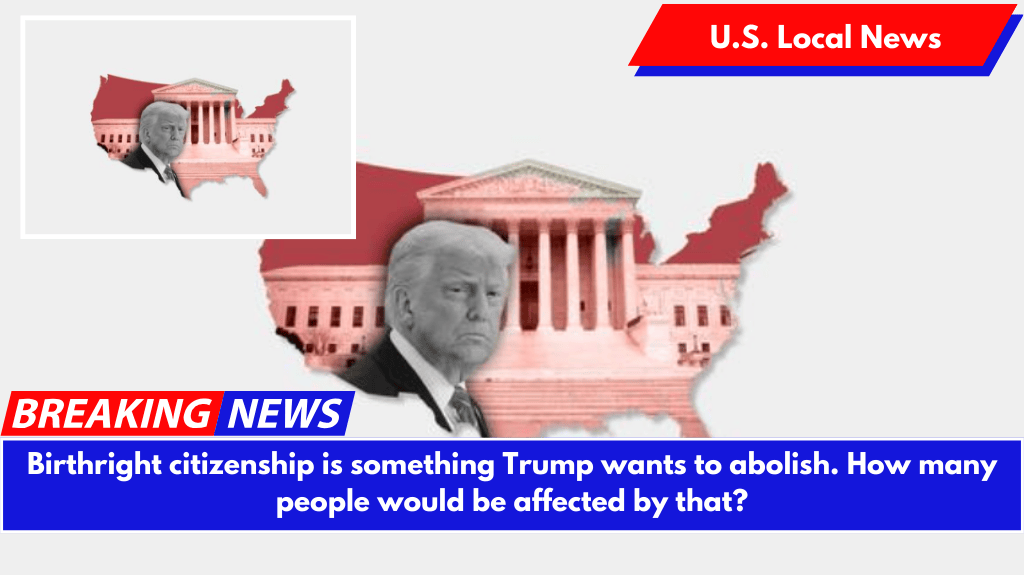For 157 years, birthright citizenship has made anyone born in the United States a citizen, regardless of whether they are the child of a citizen, a foreign national living legally in the country, or an unauthorized immigrant.
Earlier this year, President Trump issued an executive order aimed at restricting this right, which was established by the 14th Amendment in 1868. On Thursday (May 15), the Supreme Court heard arguments on the order, which would require at least one parent to be a US citizen or have permanent residency.
Changes to birthright laws would affect a sizable proportion of the US population. According to U.S. Census data for 2023, there are 22.8 million foreign-born, non-US citizens in the country.
How many people gain citizenship through birthright?
According to estimates from the Migration Policy Institute and Penn State’s Population Research Institute, ending birthright citizenship would result in an average of 255,000 children born in the United States without citizenship each year, as well as an increase in the number of unauthorized migrants living in the United States by 2.7 million by 2045 and 5.4 million by 2075.
In 2022, the Pew Research Center discovered that approximately 4.4 million US-born children under the age of 18 live with an unauthorized immigrant parent.
How many unauthorized immigrants live in the U.S.
The number of unauthorized immigrants in the United States has increased since 1990, peaking at 12.2 million in 2007, according to estimates from the Pew Research Center.
Where does the foreign-born population live in the United States?
In 2022, California was home to nearly a quarter of the United States’ foreign-born population. According to the Census Bureau, foreign-born populations accounted for more than 20% of the total population in New Jersey, New York, California, and Florida.
Foreign-born residents are people who were born outside of the United States, including naturalized citizens, lawful permanent residents, temporary migrants like international students, humanitarian migrants like refugees or asylum seekers, and unauthorized immigrants.
In nearly every state, the foreign-born population increased in 2022 compared to 2010. Between 2010 and 2022, the largest increases in foreign-born populations occurred in Delaware, North Dakota, South Dakota, and West Virginia, with each state experiencing a 40% or greater increase.
The number of foreign-born people in the United States has grown over the last 50 years. In 1970, 4.7% of the United States’ population was born outside the country. Foreign-born people accounted for 13.9% of the U.S. population in 2022.
Where are foreign-born U.S. residents immigrating from?
According to the Census Bureau, more than half of all foreign-born residents in the United States came from Latin American countries. Nearly one-third of residents are Asian immigrants.
What is naturalization?
According to the Council on Foreign Relations, naturalization is the process by which a non-US citizen can apply for citizenship after meeting certain requirements, such as passing a civics test, demonstrating basic English proficiency, and living in the United States for an extended period of time.
By 2023, nearly 25 million foreign-born residents in the United States had become naturalized citizens. The remainder consists of both lawful residents and unauthorized migrants.
Which countries grant birthright citizenship?
According to World Population Review’s map of birthright citizenship around the world, at least 35 nations grant birthright citizenship to anyone born within their borders.
What’s next?
On May 15, the Trump administration attempted to persuade the Supreme Court to allow it to broadly enforce the president’s new rules ending birthright citizenship for some, despite the fact that multiple lower courts have ruled that his executive order is most likely unconstitutional.
Several justices expressed concerns about the use of nationwide injunctions during oral arguments before the Supreme Court, but John Sauer, President Donald Trump’s solicitor general, faced criticism this week for limiting injunctions in this case.
While the government argued that Trump’s policy should apply to anyone who does not challenge it, some justices questioned the practical implications of this patchwork scenario. And they claimed that the administration avoided asking the Supreme Court to rule directly on the policy because they knew they would lose.
The justices are expected to rule before the end of June.











